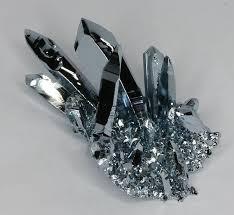METAL OSMIUM
The densest substance on Earth is the metal osmium.
Osmium "smell" is a chemical element with the symbol Os and atomic number 76. It is a hard, brittle, bluish-white transition metal in the platinum group that is found as a trace element in alloys, mostly in platinum ores. Osmium is the densest naturally occurring element, with an experimentally measured (using x-ray crystallography) density of 22.59 g/cm3. Manufacturers use its alloys with platinum, iridium, and other platinum-group metals to make fountain pen nib tipping, electrical contacts, and other applications that require extreme durability and hardness. The element's abundance in the Earth's crust is among the rarest.
Osmium has a blue-gray tint and is the densest stable element; it is approximately twice as dense as lead and slightly denser than iridium. Calculations of density from the X-ray diffraction data may produce the most reliable data for these elements, giving a value of 22.587±0.009 g/cm3 for osmium, slightly denser than the 22.562±0.009 g/cm3 of iridium; both metals are nearly 23 times as dense as water.
Osmium is a hard but brittle metal that remains lustrous even at high temperatures. It has very low compressibility. Correspondingly, its bulk modulus is extremely high, reported between 395 and 462 GPa, which rivals that of a diamond (443 GPa). The hardness of osmium is moderately high at 4 GPa. Because of its hardness, brittleness, low vapor pressure (the lowest of the platinum-group metals), and very high melting point (the fourth highest of all elements, after only carbon, tungsten, and rhenium), solid osmium is difficult to machine, form, or work.
Source: Ultimate Facts App
Photo Source: ThoughtCo
The densest substance on Earth is the metal osmium.
Osmium "smell" is a chemical element with the symbol Os and atomic number 76. It is a hard, brittle, bluish-white transition metal in the platinum group that is found as a trace element in alloys, mostly in platinum ores. Osmium is the densest naturally occurring element, with an experimentally measured (using x-ray crystallography) density of 22.59 g/cm3. Manufacturers use its alloys with platinum, iridium, and other platinum-group metals to make fountain pen nib tipping, electrical contacts, and other applications that require extreme durability and hardness. The element's abundance in the Earth's crust is among the rarest.
Osmium has a blue-gray tint and is the densest stable element; it is approximately twice as dense as lead and slightly denser than iridium. Calculations of density from the X-ray diffraction data may produce the most reliable data for these elements, giving a value of 22.587±0.009 g/cm3 for osmium, slightly denser than the 22.562±0.009 g/cm3 of iridium; both metals are nearly 23 times as dense as water.
Osmium is a hard but brittle metal that remains lustrous even at high temperatures. It has very low compressibility. Correspondingly, its bulk modulus is extremely high, reported between 395 and 462 GPa, which rivals that of a diamond (443 GPa). The hardness of osmium is moderately high at 4 GPa. Because of its hardness, brittleness, low vapor pressure (the lowest of the platinum-group metals), and very high melting point (the fourth highest of all elements, after only carbon, tungsten, and rhenium), solid osmium is difficult to machine, form, or work.
Source: Ultimate Facts App
Photo Source: ThoughtCo
METAL OSMIUM
The densest substance on Earth is the metal osmium.
Osmium "smell" is a chemical element with the symbol Os and atomic number 76. It is a hard, brittle, bluish-white transition metal in the platinum group that is found as a trace element in alloys, mostly in platinum ores. Osmium is the densest naturally occurring element, with an experimentally measured (using x-ray crystallography) density of 22.59 g/cm3. Manufacturers use its alloys with platinum, iridium, and other platinum-group metals to make fountain pen nib tipping, electrical contacts, and other applications that require extreme durability and hardness. The element's abundance in the Earth's crust is among the rarest.
Osmium has a blue-gray tint and is the densest stable element; it is approximately twice as dense as lead and slightly denser than iridium. Calculations of density from the X-ray diffraction data may produce the most reliable data for these elements, giving a value of 22.587±0.009 g/cm3 for osmium, slightly denser than the 22.562±0.009 g/cm3 of iridium; both metals are nearly 23 times as dense as water.
Osmium is a hard but brittle metal that remains lustrous even at high temperatures. It has very low compressibility. Correspondingly, its bulk modulus is extremely high, reported between 395 and 462 GPa, which rivals that of a diamond (443 GPa). The hardness of osmium is moderately high at 4 GPa. Because of its hardness, brittleness, low vapor pressure (the lowest of the platinum-group metals), and very high melting point (the fourth highest of all elements, after only carbon, tungsten, and rhenium), solid osmium is difficult to machine, form, or work.
Source: Ultimate Facts App
Photo Source: ThoughtCo
0 Comments
0 Shares
2K Views
0 Reviews



